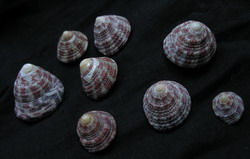Phylum Mollusca
General description
The molluscs (Americans spell it as ‘mollusks’) constitute one of the largest phyla of animals, with close to 112,000 species to be found worldwide. The scientific study of molluscs is known as malacology . The molluscs first appeared during the Cambrian period of the evolutionary calendar.The world mollusca has its root in the Latin word molluscus meaning ‘thin shelled’ which in turn is derived from the root Latin word mollis meaning ‘soft’.
This is a description of their main characteristic -all molluscs ave a soft body, which ( with the exceptions of species from certain families) is generally protected by an external, calcium-containing shell. In the octopuses and sea-slugs the shells is completely absent where as in squids it is located internally.
Main characteristics of Mollusca :
A ll modern mollusks have the same fundamental body plan. There are three distinct body zones: a head-foot, a visceral mass and a mantle. Some common features are :
- Unsegmented soft body with bilateral symmetry
- Presence of an internal or external shell
- A toothed tongue (made mostly of chitin) called the radula
- A mantle which is a fold in the body wall that lines the shell
- Muscular foot (and/or tentacles in some).
- Possession of a fluid-filled cavity called coelom
Diagram of body plan. – Shall soon appear here
The Head-foot region contains the sensory and motor organs. The foot is muscular and is used for a variety of purposes namely locomotion, capturing prey for food and attachment to the substratum.
The visceral mass contains the internal organs, namely the organs of digestive excretory and reproductive systems.
The mantle is a specialized tissue that surrounds the visceral mass but does not cover it completely; it also secretes the shell and contributes to the development of breathing organs. The mantle cavity is the space between mantle and the visceral mass. The gills are located here and the digestive, excretory and reproductive organs discharge their contents into this cavity.
Radula is a feature that is seen only in molluscs. Its structure ranges from simple tongue like ones to scrape algae off the rocks to complex harpoon-like ones seen in the cone snails that eject chemicals capable of killing humans. Most of the molluscs have gills to obtain the oxygen from water. The coelom is a haemocoel – quite reduced and found near and around the heart and as cavities around the excretory and reproductive organs
Some anatomical features :
All molluscs have a complete digestive tract starting with the mouth and ending with anus. The digestive tract is ciliated and stomach structures vary in molluscs depending upon their food intake. The undigested food is compressed and packaged into solid wastes that are sent from anus to mantle to be released outside. Many of them are filter-feeders while others are predatory.
With the exception of cephalopods all molluscs have an open circulatory system.
The blood circulates between gills and heart via the blood-filled space haemocoel.
Excretion is carried out by a pair of nephridia, who empty their contents into the mantle cavity.
Locomotion is accomplished with the help of the muscular foot. The herbivores glide where as the bivalves use it to burrow in the sand,the cephalopods swim actively creating a kind of jet propulsion by expelling water from their mantle cavity. The cuttle fishes use their lateral fins for greater maneuverability.
Molluscs have a complex nervous system made up of ganglia and nerve cords, with the octopus having the most highly evolved one. It is also considered to be a very intelligent animal with supposedly an IQ equivalent to that of a domestic cat. The giant squids have very large eyes almost the size of a quarter plate.
The basic pattern of reproduction is one of having separate sexes; but several snails are hermaphrodites. Sperm and eggs are spawned into the water, with fertilization being external, but internal fertilization can also be seen in several species. The development stages suggest a close relationship between molluscs and annelids( earthworm is an example of annelid). Some Oysters exhibit parental care.


Leave a Reply